12.1 Introduction
Radioactive material released from the Fukushima Daiichi nuclear power plant (F1-NPP) accident spread over a wide area of East Japan. Wild mushrooms often contain a high level of radiocesium in even lower contaminated areas. The University of Tokyo has seven research forests located in East Japan, 250–660 km from F1-NPP, where radiocesium contamination is low (0.02–0.12 μSv/hr. of air dose rate 1 year after the accident). These forests are used for many activities including research, education, forest management and recreation.
Radiocesium contaminated wild and cultivated mushrooms is a major concern for consumers of these forest products. Fungi, including mushrooms, are also one of the major and important components of the forest ecosystem. Radioactive contamination of mushrooms should be considered not only from the viewpoint of food but also from the viewpoint of its effects on plants and animals through its circulation in the forest ecosystem. Therefore, we have surveyed radiocesium contamination in relation to mushrooms in the University of Tokyo Forests.
Mushrooms have been reported to accumulate radiocesium (Byrne 1988; Kammerer et al. 1994; Mascanzoni 1987; Muramatsu et al. 1991; Sugiyama et al. 1990, 1994). The transfer factors (TF) for radiocesium in mushrooms were reported to be 2.6–21 in culture tests (Ban-nai et al. 1994). However, the radiocesium concentration ratio in mushrooms relative to the soil was rather low and the ratio was often <1 in a field study (Heinrich 1992). Symbiotic mycorrhizal mushrooms tend to have higher TF of 137Cs than the saprobic fungi in general, though different mushroom species also have widely varying degrees of radiocesium activity (Heinrich 1992; Sugiyama et al. 1993).
Another feature of fungi is the considerable proportion of 137Cs in forest soil is retained by the fungal mycelia, and fungi are considered to prevent the elimination of radiocesium from ecosystems (Brückmann and Wolters 1994; Guillitte et al. 1994; Vinichuk and Johanson 2003; Vinichuk et al. 2005). Thus, fungal activity is likely to contribute substantially to the long-term retention of radiocesium in the organic layers of forest soil by recycling and retaining radiocesium between fungal mycelia and soil (Muramatsu and Yoshida 1997; Steiner et al. 2002; Yoshida and Muramatsu 1994, 1996). In fact, some examples of long-term 137Cs radioactivity persistence in mushrooms in forests and transfer to animals have been reported, whereas that in plants had short ecological half-lives (Fielitz et al. 2009; Kiefer et al. 1996; Zibold et al. 2001).
In previous reports (Yamada 2013; Yamada et al. 2013), radiocesium contamination of wild mushrooms in the University of Tokyo Forests half a year after the Fukushima accident has been summarized. We found rapid uptake of radiocesium in one species of mushroom after the Fukushima accident and residual contamination from atmospheric nuclear weapons tests (NWT) or the Chernobyl accident. In the current study, the dynamics of radiocesium were surveyed over a 5 year period in wild mushrooms and their substrates (litter, soil or wood debris) in relatively low-contaminated forest areas, and features of the dynamics of mushroom contamination were elucidated, paying attention to accumulation and retention of radiocesium in mushroom related forest ecosystems. The raw data of our surveys were presented in Yamada et al. (2018).
12.2 Research Sites and Sampling
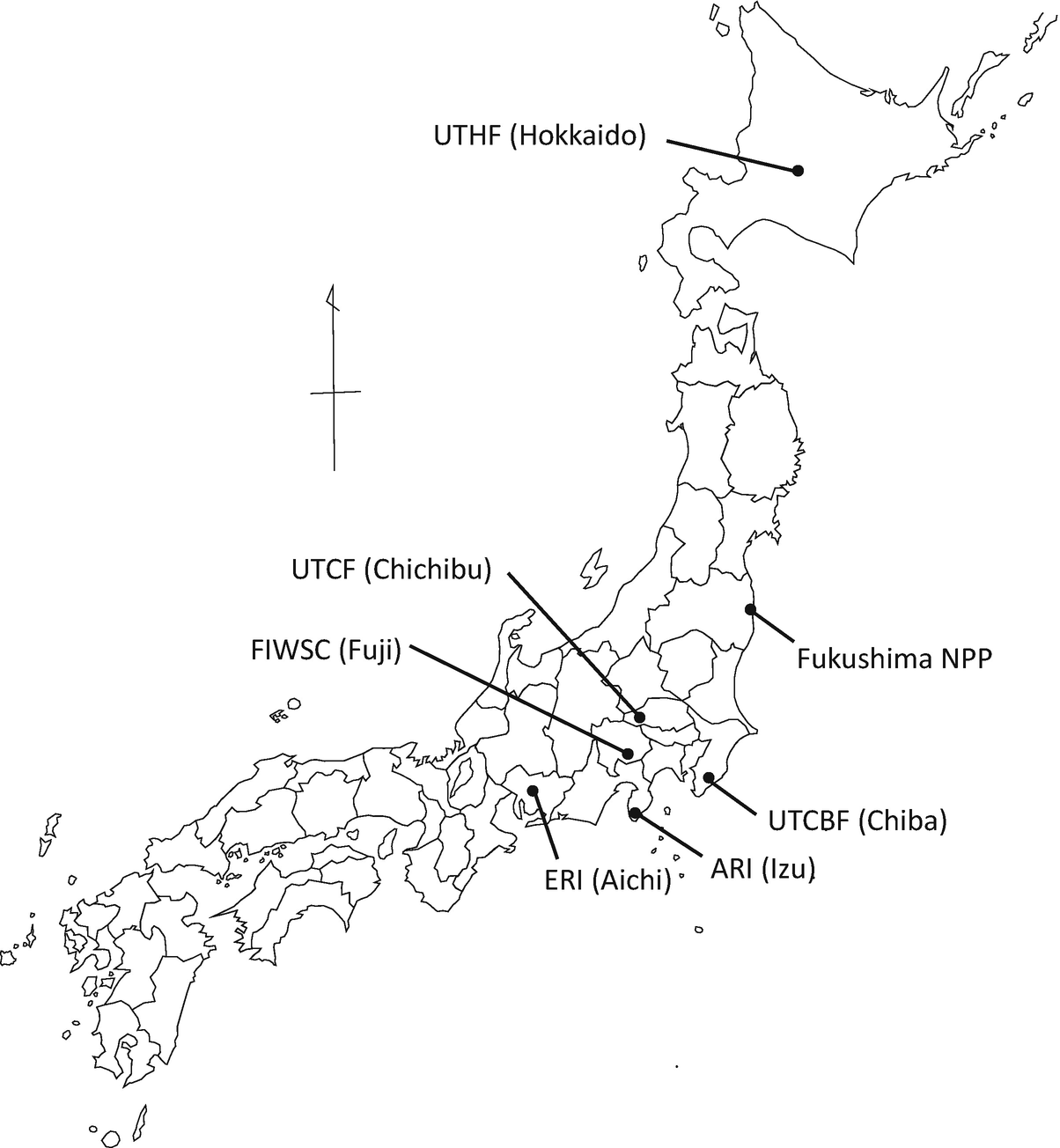
Locations of the University of Tokyo Forests from where samples were obtained
Fukushima NPP, Fukushima Daiichi nuclear power plant
UTHF The University of Tokyo Hokkaido Forest (Hokkaido), 660 km from F1-NPP, UTCF The University of Tokyo Chichibu Forest (Chichibu), 250 km from F1-NPP, FIWSC Fuji Iyashinomori Woodland Study Center (Fuji) (formerly Forest Therapy Research Institute, FTRI), 300 km from F1-NPP, UTCBF The University of Tokyo Chiba Forest (Chiba), 260 km from F1-NPP, ARI Arboricultural Research Institute (Izu), 360 km from F1-NPP, ERI Ecohydrology Research Institute (Aichi), 420 km from F1-NPP
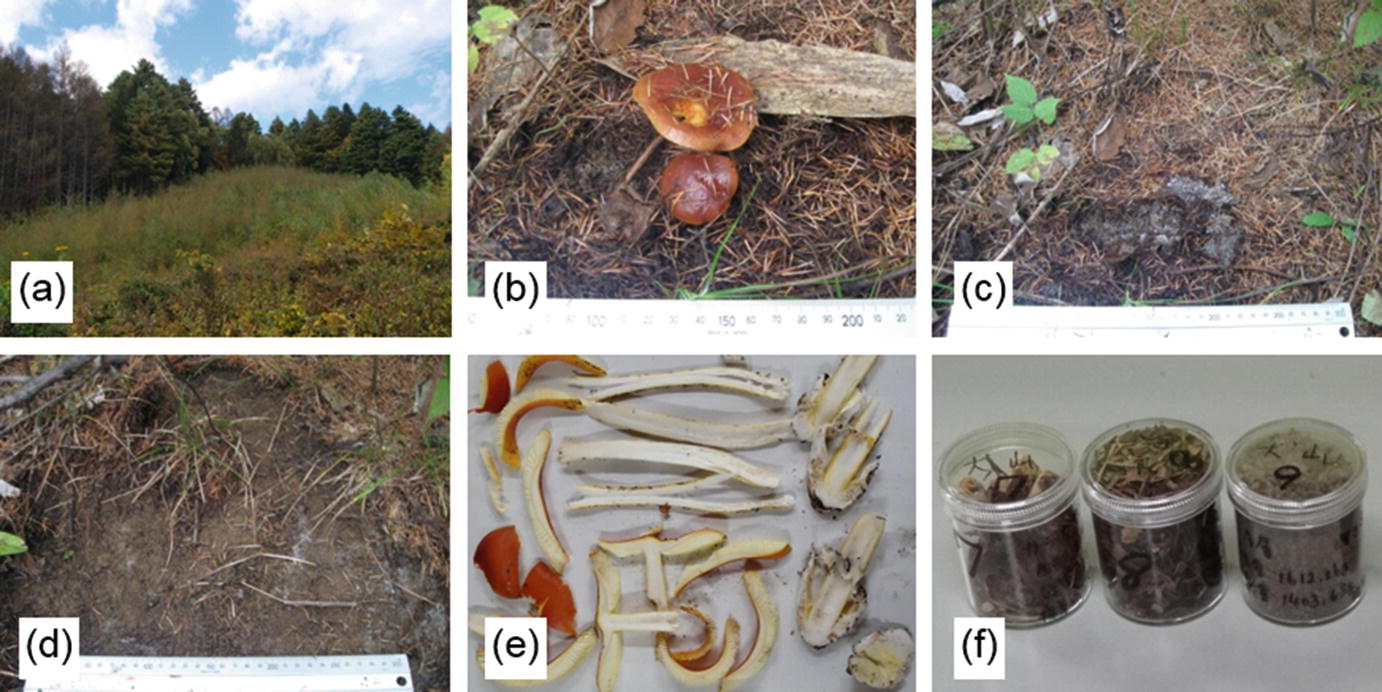
Sampling of mushrooms and soils
(a) Deciduous mixed forest where Suillus grevillea mushrooms were collected in Hokkaido (UTHF); (b) S. grevillea mushrooms in Hokkaido; (c) litter layer (O horizon) under S. grevillea mushrooms; (d) surface soil (A horizon) under S. grevillea mushrooms; (e) Slices of Amanita caesareoides mushrooms collected in Fuji (FIWSC); (f) Mushroom and soil samples were placed into U-8 containers. (Photo by K. Iguchi (a, b, c, d) and H. Saito (e))
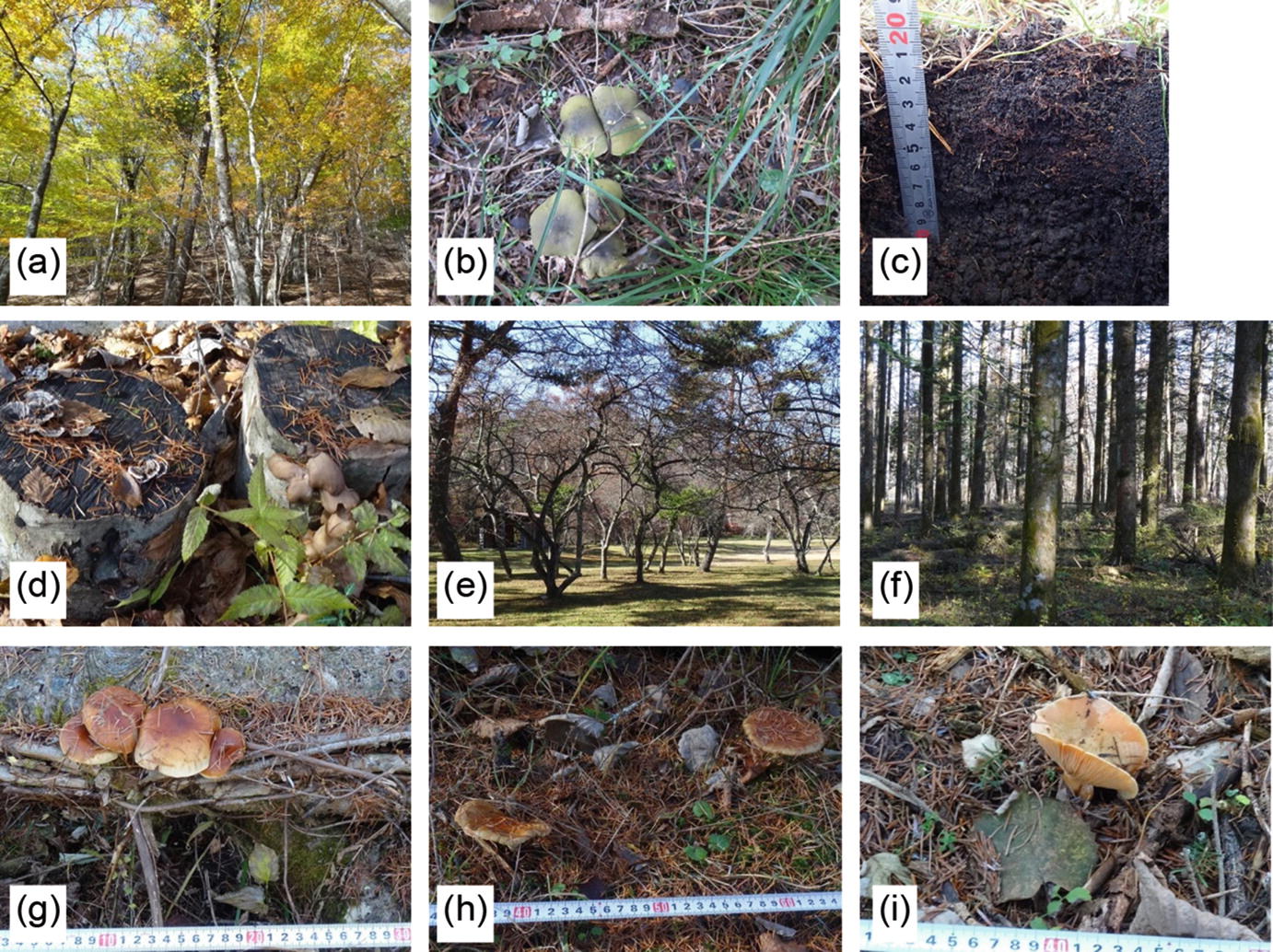
Examples of collected mushrooms and forests where mushrooms grew
(a) Deciduous mixed forest where Russula emetica mushrooms were collected in Chichibu (UTCF); (b) Tricholoma saponaceum mushrooms on flat land in Chichibu; (c) Soil profile in Fuji (FIWSC). O horizon and C/O horizon were observed; (d) Saprobic mushrooms, Pholiota microspora (left) and Pleurotus ostreatus (right), cultivated on the wood logs in Fuji. Wild Armillaria mellea mushrooms were also collected; (e) Mixed forest of Pinus densiflora and Malus toringo on Yamanaka-ko lakeside in Fuji; Suillus luteus and Lactarius hatsudake mushrooms were collected; (f) Abies homolepis forest in Fuji showing Pholiota lubrica mushrooms on a felled tree (g) and on soil (h), and mycorrhizal Lactarius laeticolor mushrooms on soil (i) were collected. (Photo by K. Takatoku (b) and H. Saito (c))
Lists of radiocesium-measured mushrooms
Research forest | Lifestyle | Species | Japanese name |
|---|---|---|---|
UTHF (Hokkaido) | M | Lyophyllum connatum | Oshiroishimeji |
M | Suillus grevillea | Hanaiguchi | |
UTCF (Chichibu) | M | Russula emetica | Dokubenitake |
M | Tricholoma saponaceum | Mineshimeji | |
S | Bondarzewia berkeleyi | Oomiyamatonbimai | |
S | Hericium erinaceum | Yamabushitake | |
S | Sarcomyxa edulis (synonym Panellus serotinus) | Mukitake | |
S | Trametes versicolor | Kawaratake | |
FIWSC (Fuji) | M | Amanita caesareoides | Tamagotake |
M | Chroogomphus rutilus | Kugitake | |
M | Lactarius hatsudake | Hatsutake | |
M | Lactarius laeticolor | Akamomitake | |
M | Lyophyllum shimeji | Honshimeji | |
M | Suillus grevillea | Hanaiguchi | |
M | Suillus luteus | Numeriiguchi | |
M | Suillus viscidus | Shironumeriiguchi | |
S | Armillaria mellea | Naratake | |
S | Pholiota lubrica | Chanametsumutake | |
S | Hypholoma sublateritium | Kuritake | |
S | Lentinula edodes | Shiitake | |
S | Pholiota microspora | Nameko | |
S | Pleurotus ostreatus | Hiratake | |
UTCBF (Chiba) | M | Catathelasma imperial | Oomomitake |
12.3 Gamma Ray Air Dose Rate at the Mushroom Collection Sites (Fig. 12.4)
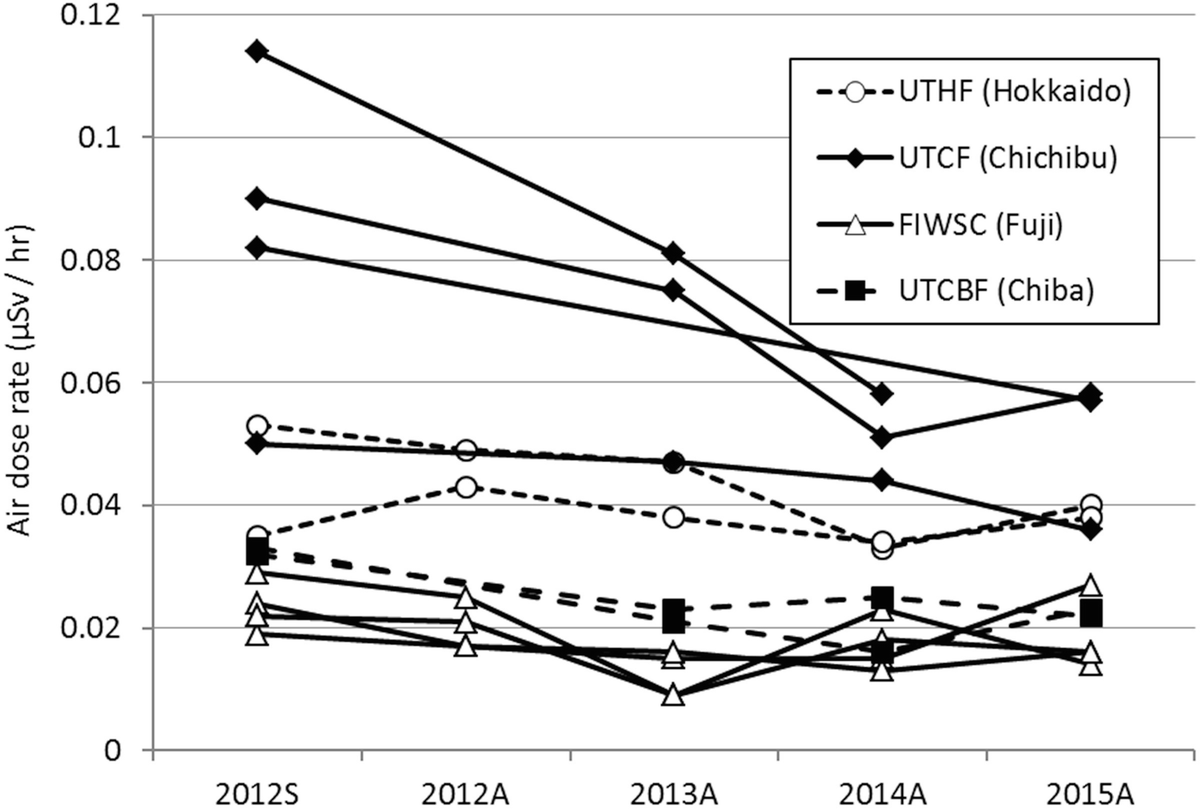
Change in air dose rate 1 m above ground at each University of Tokyo Forest
S spring, A autumn
12.4 Dynamics of Radiocesium in Each of the University of Tokyo Forests (Fig. 12.5)
12.4.1 Litter and Soil Layer
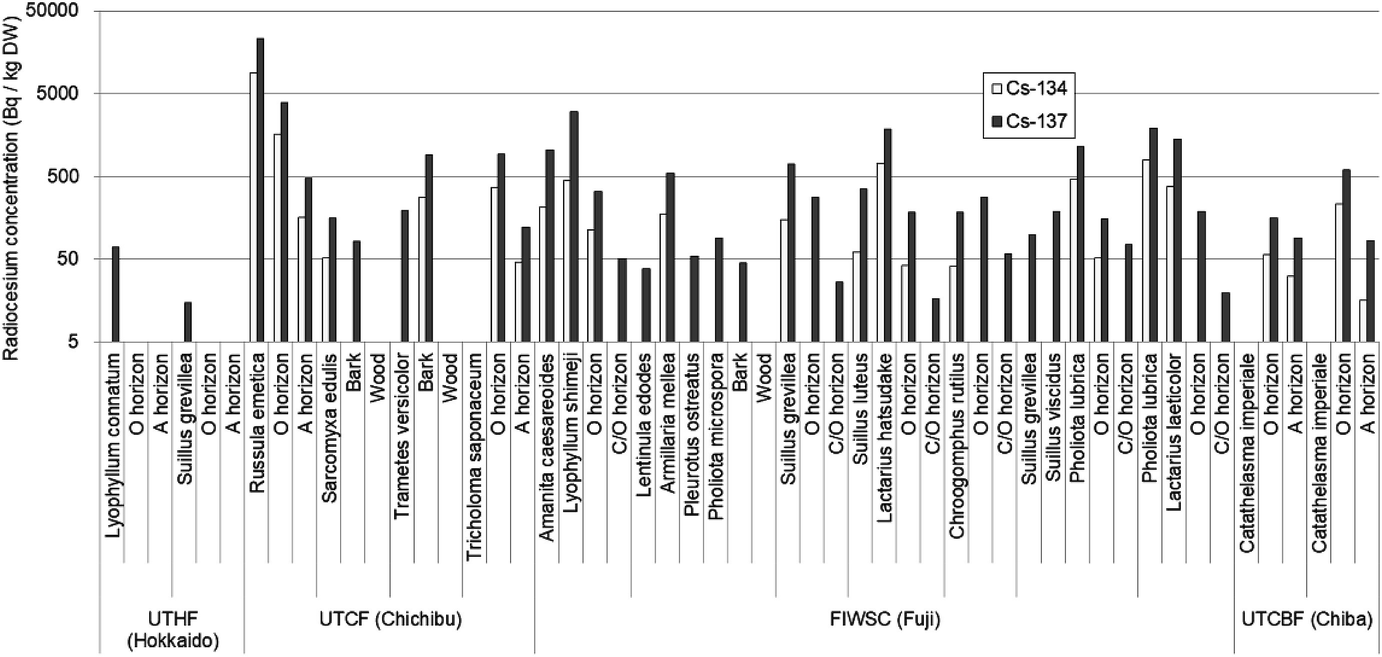
Radiocesium concentration in mushrooms and soils in each Research Forest in 2013
No data: radiocesium concentration was below the detection limit
Chichibu (UTCF): Radiocesium levels in the O horizon were high (200–4400 Bq/kg DW) half a year after the accident, and then decreased relatively rapidly. At the same time, the A horizon also contained 134Cs (20–120 Bq/kg DW), indicating a rapid transfer to the A horizon because 134Cs derived from past emissions had already decayed. Subsequent transfer to the A horizon was recognized for example in Tricholoma saponaceum-collected site, however, transfer was generally small. It was possible that radiocesium was mobilizing to lower regions such as valleys or colluvial slope because of steep slopes, with the exception of a few sites (e.g., the flat land where T. saponaceum was collected).
Chiba (UTCBF): Radiocesium decreased in the O horizon with time. A certain proportion of radiocesium appeared to transfer into the A horizon even by 2012, however, no clear subsequent transfer was recognized; It might reach a stable condition because of local environmental factors.
Fuji (FIWSC): A unique feature of FIWSC is that a C/O horizon of volcanic Scoria exists instead of an A horizon. FIWSC is covered with Scoria which is a volcanic immature soil ejected from Mt. Fuji. The transfer of radiocesium from the O horizon to the C/O horizon was low (see below). A large proportion of mycorrhizal mycelia may exist in the surface litter layer, and this resulted in mushrooms accumulating a larger amount of radiocesium. Outside of Fuji, heavily contaminated mushrooms have been repeatedly reported around Mt. Fuji despite being a low-contaminated area. A considerable proportion of the contamination was thought to be derived from nuclear weapons testing and the Chernobyl accident.
12.4.2 Mushrooms
Russula emetica in Chichibu had a high level of radiocesium. Soil analyzed from the R. emetica-collection site was also highly contaminated compared with other sites in Chichibu; fallout from the radioactive plume appeared to have deposited here by chance. The dose rate of this highly contaminated site, however, was lower than that of the surrounding sites. The level of 137Cs in Pholiota lubrica, collected in Fuji, which absorbed quite a high level of radiocesium in the first year of the accident, gradually decreased in one site but remained at the initial level for 4 years in another site. Dynamics of 137Cs in the O horizon might reflect the difference because mycelia of P. lubrica was spread widely in the O horizon. Six months after the accident, Fukushima-derived radiocesium concentration in mushrooms was lower than that of soils except for P. lubrica. Some mycorrhizal mushrooms such as Suillus grevillea, S. viscidus, Amanita caesareoides, Lyophyllum shimeji and Lactarius laeticolor in Fuji contained less 134Cs compared with 137Cs. It was concluded that the past contamination remained (See Sect. 12.8).
Trametes versicolor in Chichibu had a low radiocesium concentration in 2011; the majority of the radiocesium seemed to be derived from the Fukushima accident judging from the proportion of 134Cs. The radiocesium content in T. versicolor was high between 2012–2014, indicating the accumulation in mycelia, but decreased in 2015. In other saprobic mushrooms, a high concentration of radiocesium was detected in Sarcomyxa edulis (synonym Panellus serotinus) in the first year of the accident, then the content decreased in 2013 and 2014 to the same level found in T. versicolor. Litter and soils of the sites, where both mushrooms were collected, were contaminated with radiocesium. Several saprobic mushrooms were collected and surveyed in Fuji; In Lentinula edodes, Pleurotus ostreatus, Armillaria mellea and Pholiota microspora, radiocesium level was much higher compared with bark and wood as substrates, except for bark in 2012. Radiocesium concentration was low in L. edodes and P. ostreatus but accumulated in A. mellea. Saprobes are thought to absorb radiocesium in proportion to the contamination level of the substrate. However, absorption seemed low compared with some mycorrhizal fungi. High radiocesium content in A. mellea might be due to the wide distribution of its mycelia in litter and soil, like P. lubrica and several mycorrhizal fungi.
12.5 Dynamics of Radiocesium in the Same Sampling Sites (Figs. 12.6 and 12.7)
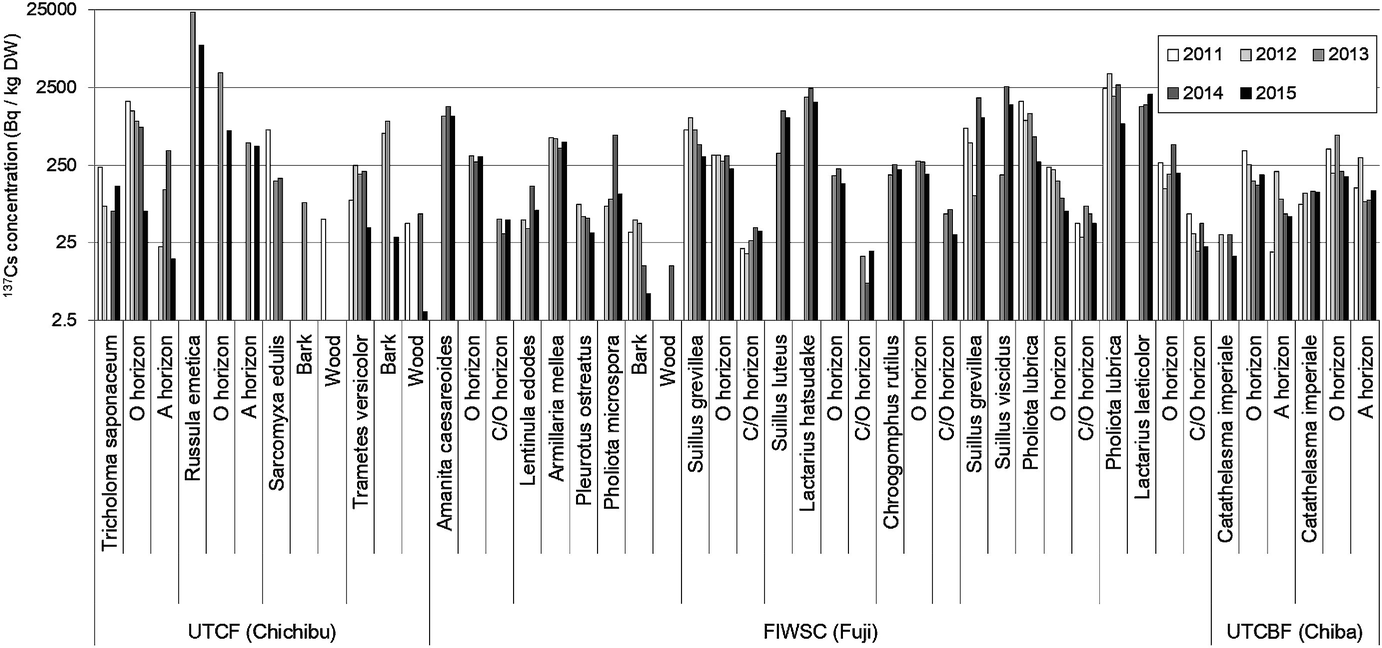
Changes in 137Cs concentration in mushrooms and soils from same sampling sites
No data: either no mushrooms were collected on the site or the radiocesium concentration was below the detection limit
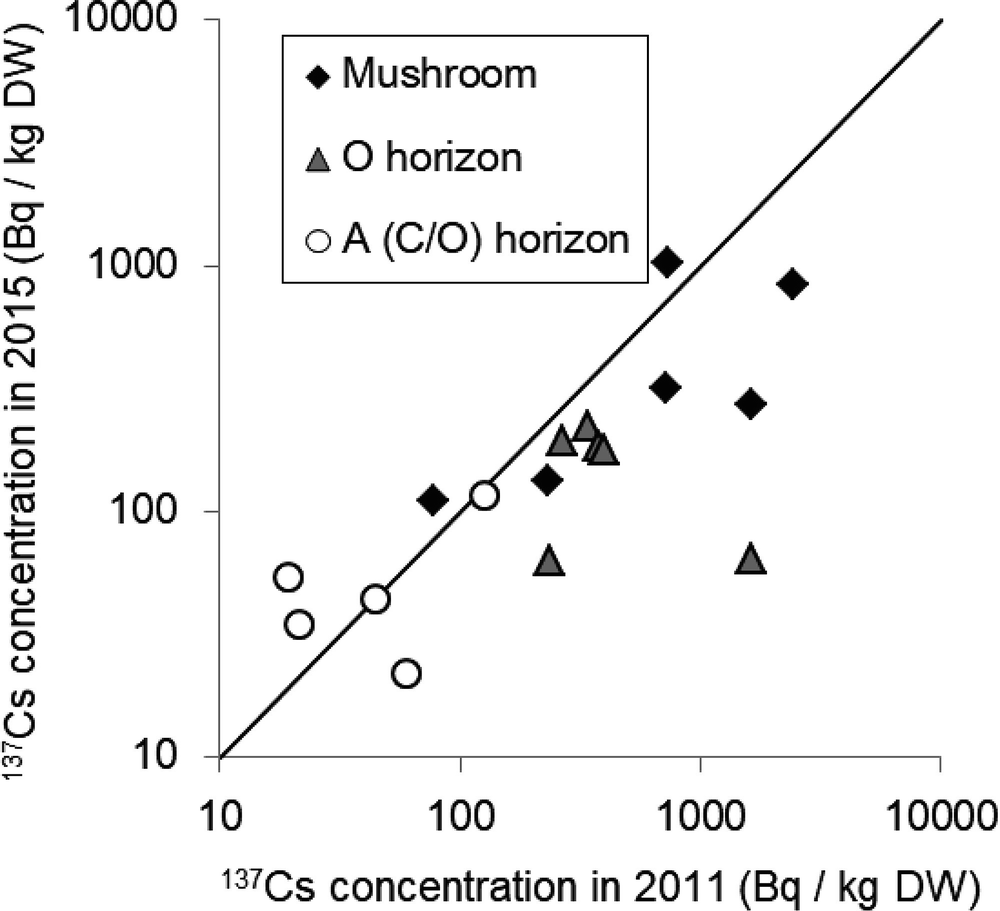
Scatter diagram indicating 137Cs changes from 2011 to 2015 in mushrooms and soils from the same sampling sites
The oblique solid line (Y = X) indicates the same 137Cs concentration between 2011 and 2015
The scatter diagram (Fig. 12.7) also showed a decrease of 137Cs with time in general. The decrease was conspicuous especially in O horizon. 137Cs concentration in A horizon was low at an early stage of post-accident and no obvious increase or reduction was observed. These results suggested a part of 137Cs migrated from the O horizon to the A horizon, but a large proportion remained in the O horizon. In the case of mushrooms, considerable variations of the changes in 137Cs level were observed between species.
12.6 The Relationship Between Radiocesium Contamination of Mycorrhizal Mushrooms and Soils (Fig. 12.8)
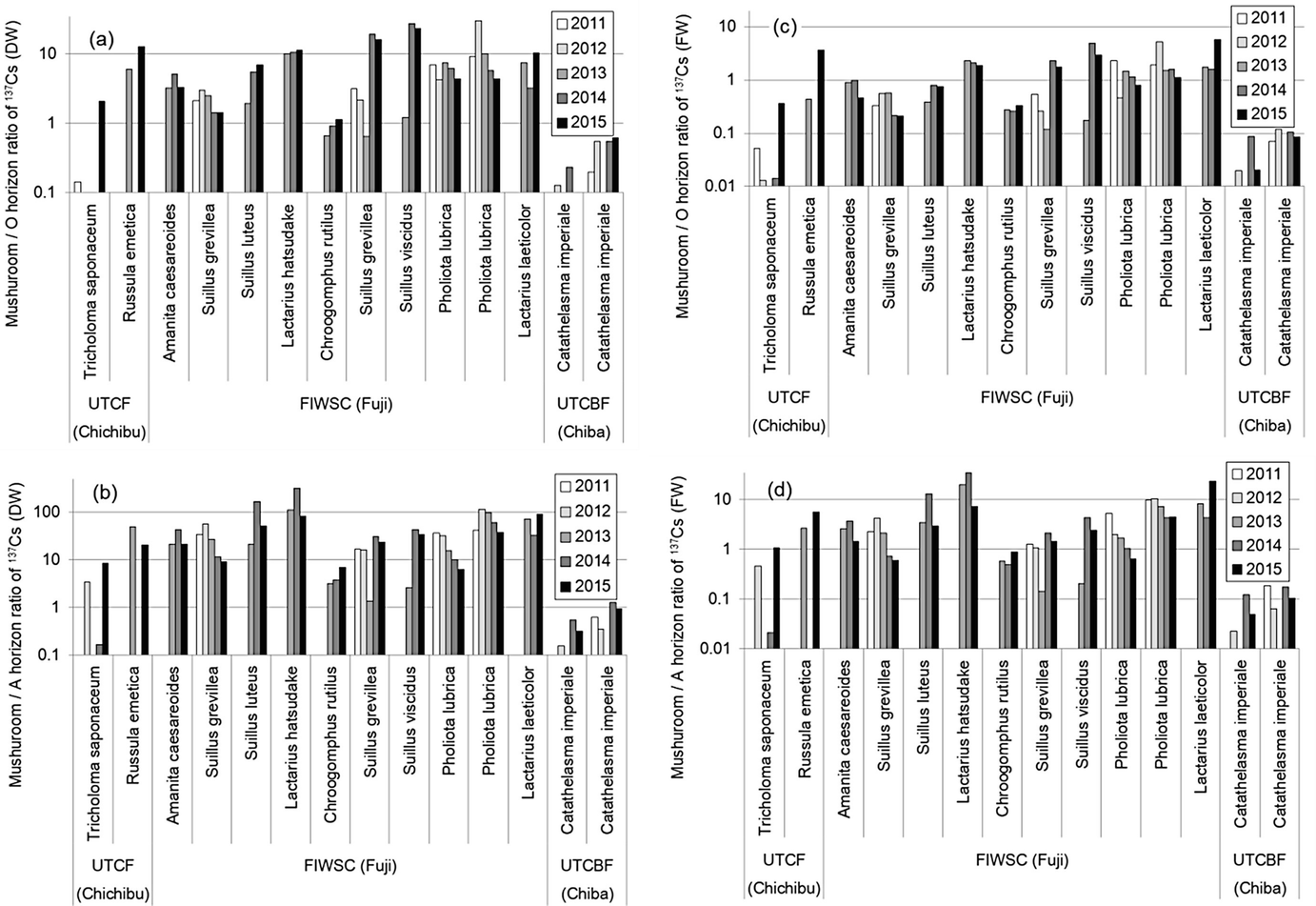
Mushroom/soils ratio of 137Cs concentration
Mushroom/O horizon ratio (a, c) or mushroom/A (C/O) horizon ratio (b, d) of 137Cs concentration on dry weight basis (a, b) or on fresh weight basis (c, d)
No data: either no mushrooms were collected on the site or the radiocesium concentration was below the detection limit
12.7 Possible Mechanism Determining Radiocesium Content – The Relationship Between 137Cs and 40K (Figs. 12.9 and 12.10)
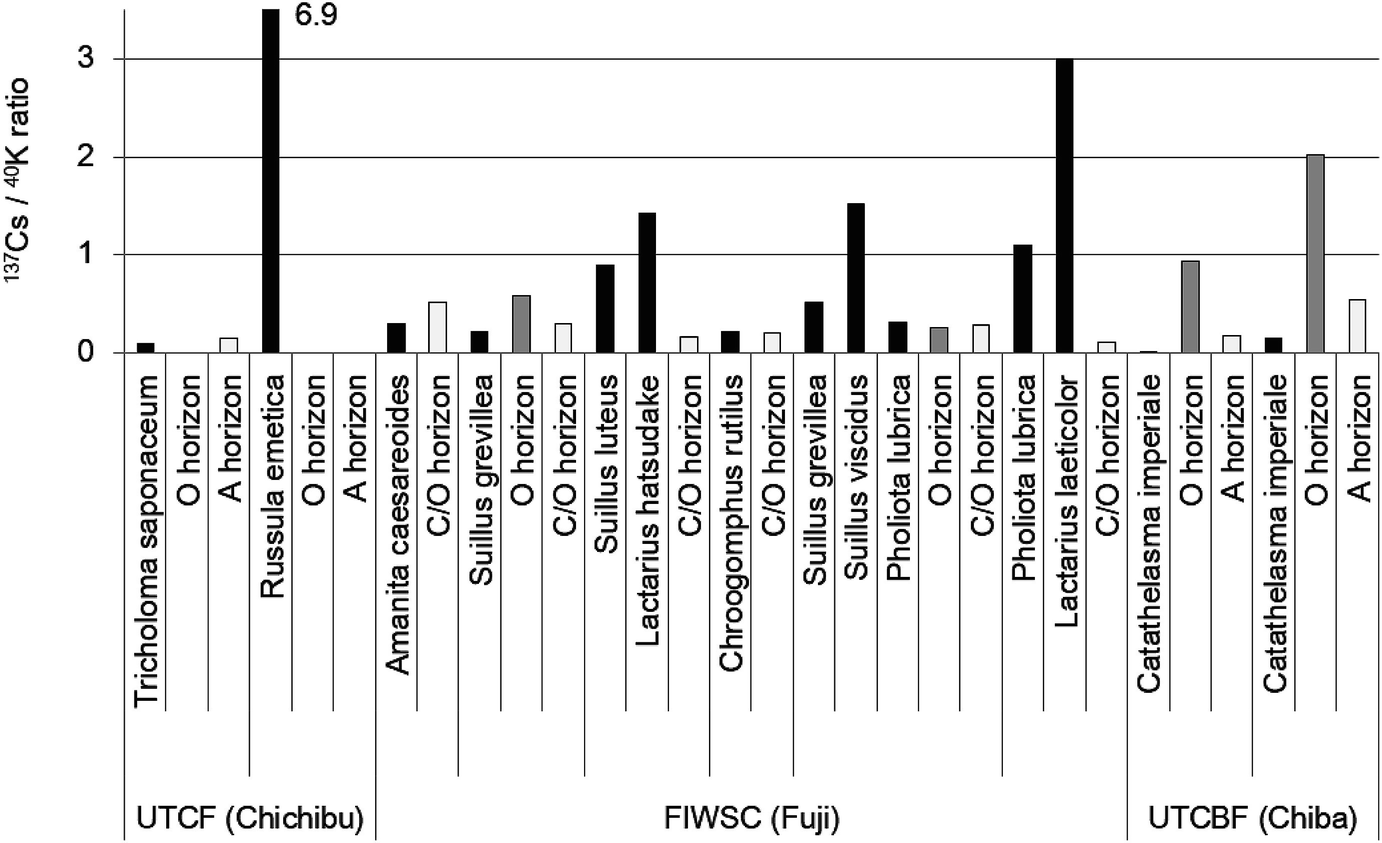
137Cs/40K ratio in mushrooms and soils in 2015
 , Mushroom;
, Mushroom;  , O horizon;
, O horizon;  , A (C/O) horizon. 137Cs/40K ratio in Russula emetica was 6.9
, A (C/O) horizon. 137Cs/40K ratio in Russula emetica was 6.9
No data: radiocesium concentration was below the detection limit
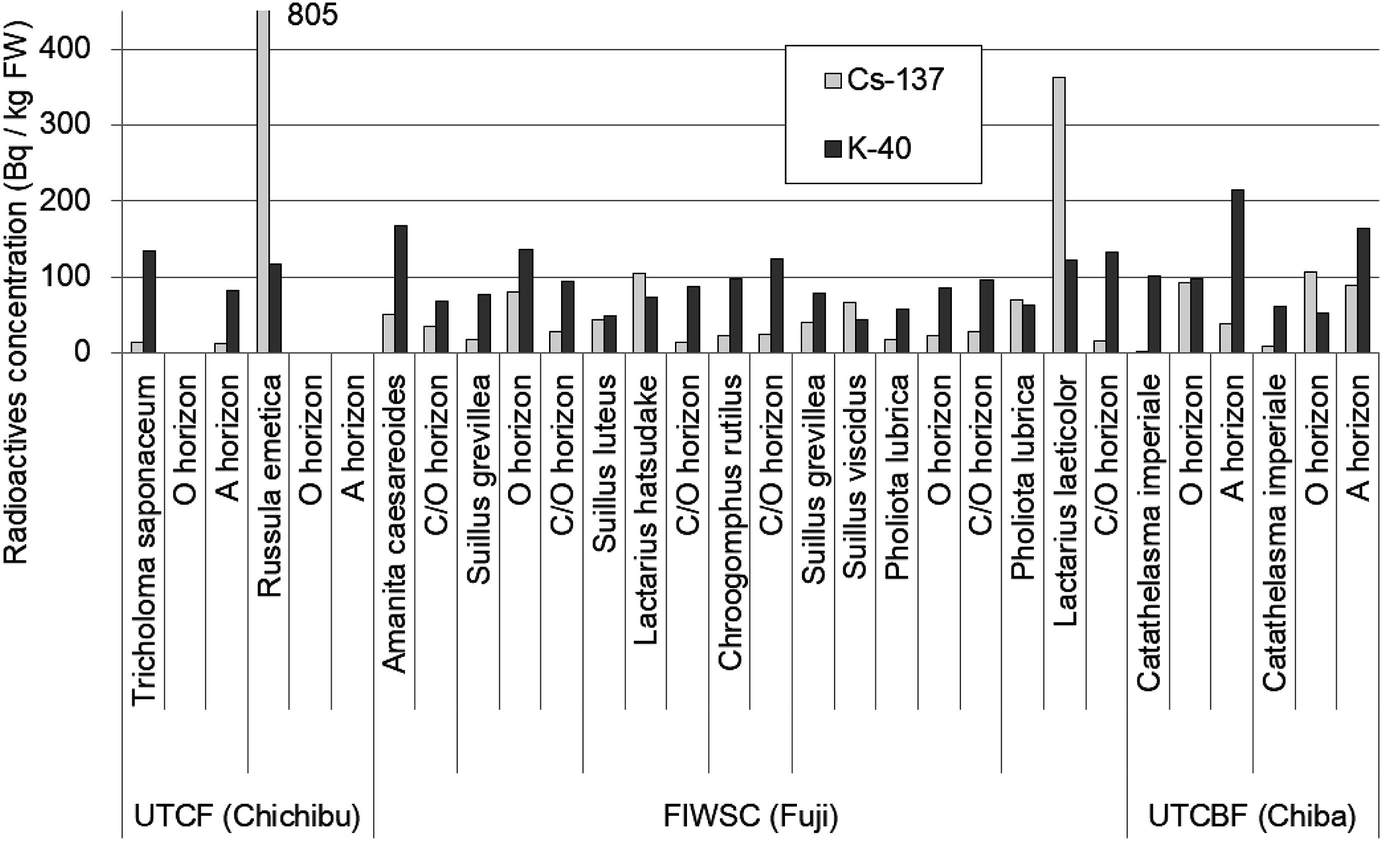
Comparison of 137Cs and 40K concentration on a fresh weight basis in 2015
137Cs concentration in Russula emetica was 805 Bq/kg FW
No data: radiocesium concentration was below the detection limit
On a dry weight basis, 40K concentration seemed high in mushrooms and low in the O or A (C/O) horizons. A reason for radiocesium contamination to be high in mushrooms appears to be because of potassium richness (Seeger 1978). The 40K level, however, was similar for the triparties on a fresh weight basis (Fig. 12.10), suggesting no special mechanism of K absorption. Becauese most K exists as ions in the cytoplasm, the difference was due to a high water content in mushrooms (a water content of 90–95% is common). The high 137Cs/40K ratio observed in Russula emetica was probably induced by heavy soil contamination. On the other hand, mushroom/O or A (C/O) horizon ratios of 137Cs for R. emetica (See Sect. 12.6) was not higher compared with Fuji mushrooms, but much higher compared with mycorrhizal fungi in Chichibu and Chiba. Some physiological or ecological mechanisms for Cs accumulation might work also in the case of R. emetica.
12.8 Features of Radioactive Contamination with Different Date of Fallout (Fig. 12.11)
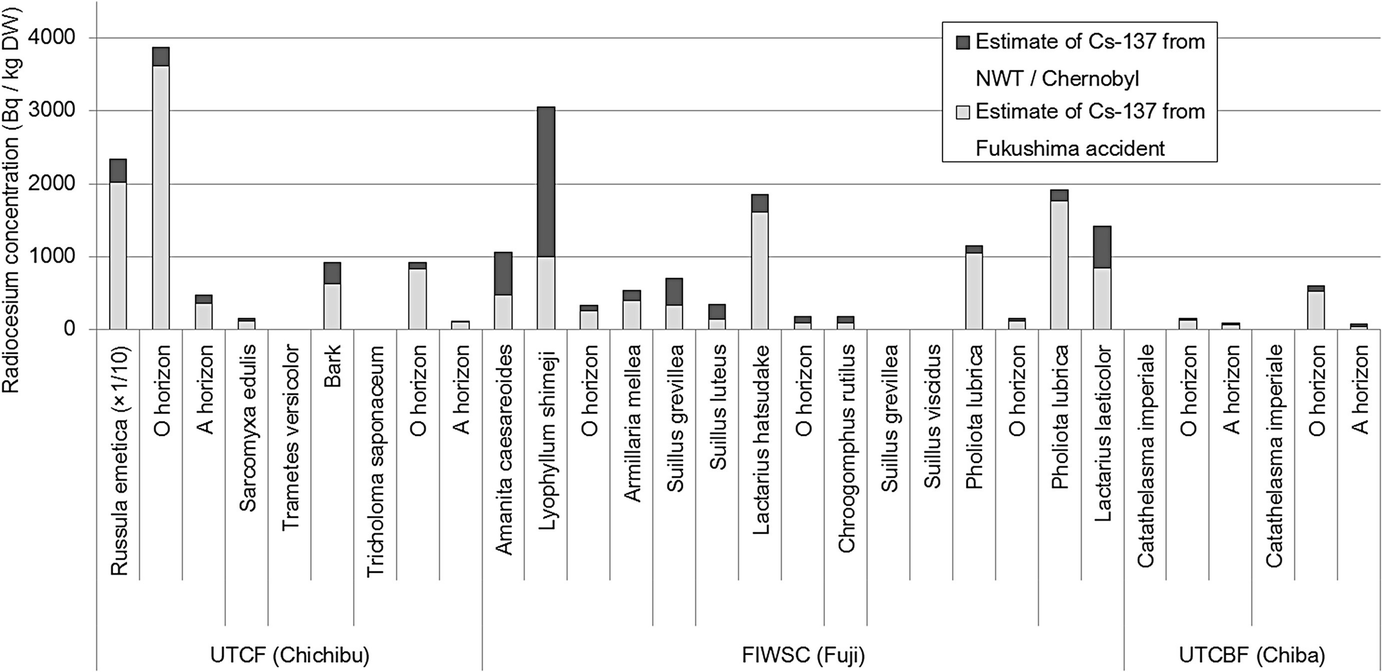
Contribution of nuclear weapons tests (NWT), the Chernobyl accident and the Fukushima accident to total radiocesium contamination in 2013
Radiocesium concentration in Russula emetica was shown as one tenth of the actual value (i.e., total 23,400 Bq/kg DW)
No data: radiocesium concentration was below the detection limit
Shortly after the Fukushima accident, a large proportion of total 137Cs in the O horizon of soils from Chichibu, Fuji and Chiba were derived from the Fukushima accident, and the 134Cs/137Cs ratio was constant among these research Forests. It showed a similar percentage contribution of contamination before the Fukushima accident. The mean contribution of the Fukushima accident to total contamination was roughly 88% in autumn 2011. This value decreased with time; 86% in 2012, 77% in 2013 and 65% in 2014. These results suggest that radiocesium released from the Fukushima accident moved relatively quickly out of the O horizon, whereas most the past residual 137Cs remained in the material cycle system on the soil surface. For example, 137Cs might have been sequestered inside mycorrhizal mycelia. However, it is far from a quantitative evaluation, because of the unstable occurrence of mushrooms between years and locations. In the A or C/O horizon, the mean ratio of Fukushima 137Cs to total 137Cs increased from 59% in 2011 to 73% in 2012, then decreased and stabilized at the equivalent level to the O horizon of about 65% in 2013 and 2014. The changes in the ratio appeared to be due to the transfer of 137Cs from the O horizon, and somewhat to the transfer out of the A horizon.
The proportion of pre-Fukushima 137Cs is high in mycorrhizal fungi, such as Suillus grevillea, S. luteus, S. viscidus, Amanita caesareoides, Lyophyllum shimeji and Lactarius laeticolor sampled in Fuji. Sugiyama et al. (2000) reported high 137Cs activities in P. lubrica and S. grevillei collected around Mt. Fuji in 1996. These fungal species can be characterized by their ability to retain radiocesium. Specifically, more than half the 137Cs was derived from pre-Fukushima fallout in S. grevillea, A. caesareoides and L. shimeji. Further, Catathelasma imperiale in Chiba had a low concentration of 137Cs, but the ratio of the pre-Fukushima 137Cs was also high. Thus, the range of radiocesium concentrations found in mycorrhizal fungi is large. It is unusual that the contribution of pre-Fukushima 137Cs fallout remained high under the influence of fallout from the Fukushima accident. The mechanisms remain unclear how fungi with a high turnover rate of cells and tissues can retain pre-Fukushima 137Cs, in which the ratio is much higher than in the soil substrate. 137Cs deposited over a few decades may continue to be circulated in a closed system of fungal mycelium, which prevents its loss to the lower soil horizons.
12.9 Conclusion
In this chapter, some of the dynamics of radiocesium contamination in the forest ecosystem in relation to mushrooms was revealed. Radiocesium accumulation in several mycorrhizal mushrooms was similar to that reported after the Chernobyl accident, but not all mushrooms were contaminated equally. Biology and ecology of mushrooms, geographical, geological and pedological features may affect radiocesium dynamics in forests. Monitoring data of radiocesium concentration could evaluate the transfer of radiocesium from the litter to the soil layer or mushrooms and will provide useful information on the mechanisms of radiocesium accumulation in relation to potassium, and the selective retention of absorbed radiocesium in mushrooms. The number of samples and period of monitoring, however, was insufficient. Long-term monitoring of 137Cs is necessary to clarify more precisely the dynamics of the contamination, though monitoring of 134Cs is now becoming difficult because of its short half-life.
Acknowledgments
I sincerely thank the staff of the University of Tokyo Forests for collecting and preparing the samples, and Drs. N. I. Kobayashi, K. Tanoi and T. M. Nakanishi for measuring the radioactivity in samples and for their valuable comments.

Open Access This chapter is licensed under the terms of the Creative Commons Attribution 4.0 International License (http://creativecommons.org/licenses/by/4.0/), which permits use, sharing, adaptation, distribution and reproduction in any medium or format, as long as you give appropriate credit to the original author(s) and the source, provide a link to the Creative Commons license and indicate if changes were made.
The images or other third party material in this chapter are included in the chapter's Creative Commons license, unless indicated otherwise in a credit line to the material. If material is not included in the chapter's Creative Commons license and your intended use is not permitted by statutory regulation or exceeds the permitted use, you will need to obtain permission directly from the copyright holder.